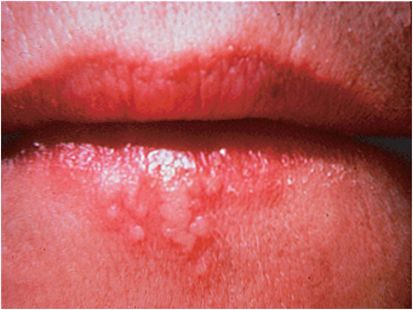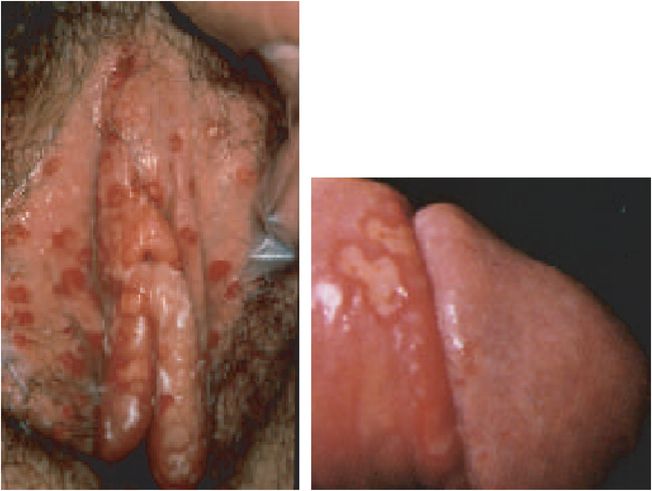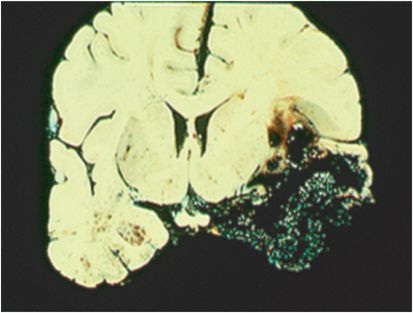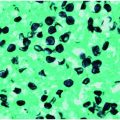Figure 187.1 Herpes simplex gingivostomatitis.
Primary infection in young adults has been associated with pharyngitis and often a mononucleosis-like syndrome. In such patients, ulcerative lesions on erythematous bases frequently are apparent on the tonsils.
Primary gingivostomatitis results in viral shedding in oral secretions for an average of 7 to 10 days. Virus is also shed in the stool.
Recurrent orolabial HSV lesions are often preceded by a prodrome of pain, burning, tingling, or itching. These symptoms generally last for less than 6 hours, followed within 24 to 48 hours by the appearance of painful vesicles, typically at the vermillion border of the lip (Figure 187.2). Lesions usually crust within 3 to 4 days, and healing is complete within 8 to 10 days. Recurrences occur only rarely in the mouth or on facial skin of immunocompetent patients.

Figure 187.2 Recurrent herpes simplex labialis.
Genital HSV infection
Genital HSV disease (Figure 187.3) is usually acquired by sexual contact with an infected partner. Historically, virtually all cases of genital herpes were caused by HSV-2 but, with changing sexual behavior, at least 50% of cases today are the consequence of HSV-1. The incubation period of primary disease ranges from 2 to 12 days. Lesions persist for an average of 21 days. In 70% of patients, primary infections are associated with fever, malaise, myalgias, inguinal adenopathy, and other signs and symptoms of systemic illness. Complications include extragenital lesions, aseptic meningitis, and sacral autonomic nervous system dysfunction with associated urinary retention. Women tend to experience more severe primary infections and are more likely to develop complications.

Figure 187.3 Genital HSV infection in woman (primary infection) and man (recurrence).
In males, primary genital HSV infection usually manifests as a cluster of vesicular lesions on erythematous bases on the glans or shaft of the penis. In females, primary genital HSV lesions usually involve the vulva bilaterally. Concomitant HSV cervicitis occurs in 90% of women with primary HSV-2 infection of the external genitalia. In women, the lesions rapidly ulcerate and become covered with a gray-white exudate. Lesions may be exquisitely painful. Recurrent genital HSV-2 infection can be either symptomatic or asymptomatic. A prodrome of itching, burning, tingling, or tenderness may be noted several hours before a recurrence. The duration of disease is shorter during recurrent infection (7 to 10 days), and fewer lesions are present. In men, lesions usually appear on the glans, or shaft, of the penis. In women, lesions occur most commonly on the labia minora, labia majora, and perineum. Cervical excretion of HSV occurs in 10% of women with recurrent genital lesions. Systemic symptoms are uncommon in recurrent genital HSV disease. Genital HSV-1 infections are much less likely to recur.
Transmission usually occurs in the absence of clinical symptoms, and occurs more often from men to women. Importantly, HSV-2 seropositive but asymptomatic individuals are just as likely to transmit infection as those who are symptomatic.
Other primary HSV skin infections
Alteration in the barrier properties of skin, as occurs in atopic dermatitis, can result in localized HSV skin infection (eczema herpeticum). Most cases resolve over a 7- to 9-day period without specific therapy. Localized cutaneous HSV infection after trauma is known as herpes gladitorium (wrestler’s herpes or traumatic herpes).
HSV infection of the digits results in herpetic whitlow. Such lesions may be the result of autoinoculation, as in the case of infants, or exogenous exposure, as occurs among medical and dental personnel who fail to wear gloves.
Ocular HSV infection
Herpetic infection of the eye usually presents as either a blepharitis or a follicular conjunctivitis. As disease progresses, branching dendritic lesions develop. Symptoms include severe photophobia, tearing, chemosis, blurred vision, and preauricular lymphadenopathy. An ophthalmologist should always be involved in the care of such patients.
Central nervous system HSV infection
Central nervous system (CNS) signs and symptoms of HSV disease can begin suddenly or can follow a 1- to 7-day period of nonspecific influenza-like symptoms. Prominent CNS features include headache, fever, altered consciousness, and focal neurologic findings such as focal seizures. Clinical signs and symptoms may reflect the characteristic frontal and temporal lobe localization, such as memory loss, anosmia, olfactory hallucinations, speech disorders, and behavioral disturbances, often accompanied pathologically by focal necrosis (Figure 187.4).

Figure 187.4 Brain with temporal lobe necrosis.
Neonatal HSV infections
Stay updated, free articles. Join our Telegram channel

Full access? Get Clinical Tree





